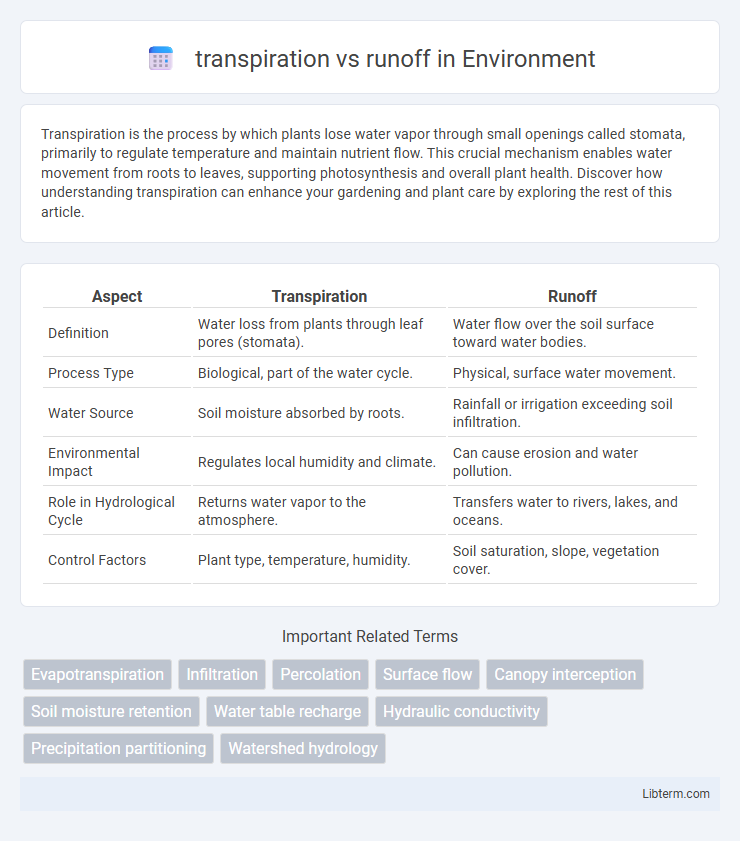Transpiration is the process by which plants lose water vapor through small openings called stomata, primarily to regulate temperature and maintain nutrient flow. This crucial mechanism enables water movement from roots to leaves, supporting photosynthesis and overall plant health. Discover how understanding transpiration can enhance your gardening and plant care by exploring the rest of this article.
Table of Comparison
| Aspect | Transpiration | Runoff |
|---|---|---|
| Definition | Water loss from plants through leaf pores (stomata). | Water flow over the soil surface toward water bodies. |
| Process Type | Biological, part of the water cycle. | Physical, surface water movement. |
| Water Source | Soil moisture absorbed by roots. | Rainfall or irrigation exceeding soil infiltration. |
| Environmental Impact | Regulates local humidity and climate. | Can cause erosion and water pollution. |
| Role in Hydrological Cycle | Returns water vapor to the atmosphere. | Transfers water to rivers, lakes, and oceans. |
| Control Factors | Plant type, temperature, humidity. | Soil saturation, slope, vegetation cover. |
Introduction to Transpiration and Runoff
Transpiration is the process by which plants release water vapor into the atmosphere through stomata, playing a crucial role in the water cycle and influencing local humidity levels. Runoff occurs when excess surface water from precipitation flows over the land, contributing to streams, rivers, and lakes while affecting soil erosion and nutrient distribution. Understanding the balance between transpiration and runoff is essential for managing water resources and predicting hydrological responses in different ecosystems.
Defining Transpiration in the Water Cycle
Transpiration is the process by which water absorbed by plant roots is evaporated into the atmosphere through small pores called stomata on leaf surfaces. This vital component of the water cycle contributes significantly to atmospheric moisture, influencing local and global climate patterns. Unlike runoff, which involves surface water flow over land, transpiration facilitates the movement of water within the biosphere, cycling water from soil to air.
Understanding Runoff Processes
Runoff occurs when precipitation exceeds the infiltration capacity of the soil, causing excess water to flow over the land surface. This process is influenced by factors such as soil type, land slope, vegetation cover, and rainfall intensity, which determine how much water is absorbed versus how much becomes surface runoff. Understanding runoff is critical for managing flood risks, soil erosion, and water quality in urban and agricultural landscapes.
Key Differences Between Transpiration and Runoff
Transpiration is the process by which water absorbed by plant roots evaporates from leaf surfaces, playing a crucial role in the water cycle by releasing moisture into the atmosphere. Runoff refers to the movement of excess surface water from rainfall or melting snow that flows over the land, contributing to river streams and potentially causing erosion. Key differences include transpiration being a biological process linked to plant activity, while runoff is a physical hydrological process influenced by terrain and soil saturation.
Environmental Factors Influencing Transpiration
Environmental factors influencing transpiration include temperature, humidity, wind speed, and soil moisture levels, which directly affect the rate at which water vapor is released from plant leaves. Higher temperatures increase the vapor pressure deficit, promoting greater transpiration rates, while high humidity reduces this gradient, limiting water loss. Wind increases the removal of saturated air around stomata, enhancing transpiration, whereas adequate soil moisture ensures sufficient water availability for continuous transpiration.
Environmental Factors Influencing Runoff
Environmental factors such as soil type, vegetation cover, and rainfall intensity significantly influence runoff rates. Impermeable soils and sparse vegetation increase surface runoff by reducing water infiltration, while dense plant roots enhance transpiration and soil absorption. High rainfall intensity exceeds soil absorption capacity, leading to greater runoff and potential erosion.
Impact of Vegetation on Transpiration and Runoff
Vegetation significantly influences transpiration by absorbing soil moisture and releasing water vapor, which reduces surface runoff and promotes groundwater recharge. Dense plant cover increases water infiltration, decreases soil erosion, and moderates the hydrological cycle by balancing transpiration and runoff. Forested areas typically exhibit higher transpiration rates and lower runoff compared to barren or urban landscapes, highlighting vegetation's critical role in water management.
Effects on Ecosystem and Water Resources
Transpiration regulates local humidity and supports plant health by returning water vapor to the atmosphere, enhancing ecosystem stability and promoting groundwater recharge. Runoff, in contrast, can lead to soil erosion, nutrient depletion, and increased sediment load in water bodies, negatively impacting aquatic habitats and reducing water quality. Effective management of transpiration and runoff processes is critical for maintaining water resources, preventing floods, and sustaining biodiversity in terrestrial and aquatic ecosystems.
Human Activities Affecting Transpiration and Runoff
Human activities such as urbanization, deforestation, and agriculture significantly alter transpiration and runoff patterns by changing land cover and soil properties. Impervious surfaces in urban areas reduce infiltration, increasing runoff volumes and peak flow rates, while deforestation decreases transpiration due to reduced vegetation cover, leading to higher surface runoff and potential soil erosion. Agricultural practices like irrigation and crop selection modify transpiration rates, influencing local hydrological cycles and impacting water availability downstream.
Conclusion: Balancing Transpiration and Runoff for Sustainability
Effective water management hinges on balancing transpiration and runoff to sustain ecosystems and agricultural productivity. Optimizing plant transpiration enhances soil moisture retention, reduces runoff, and mitigates erosion while supporting photosynthesis and carbon cycling. Implementing strategies such as afforestation and smart irrigation promotes this balance, ensuring water resources are conserved and ecosystem health is maintained.
transpiration Infographic

 libterm.com
libterm.com